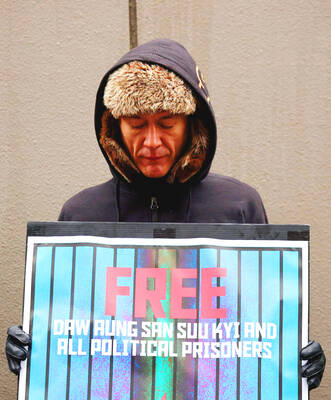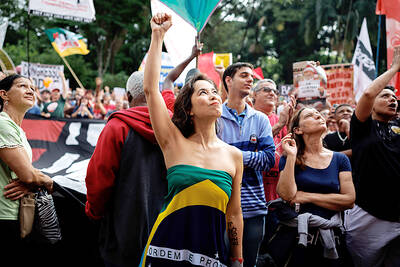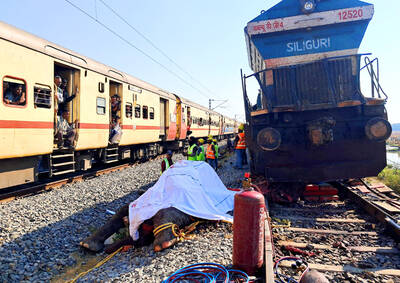An al-Qaeda suspect was killed and another arrested in Pakistan, and authorities tried to determine on Thursday if the detained man is a Syrian who has a multimillion-dollar bounty on his head and once taught militants at Osama bin Laden's terror camps in Afghanistan.
Intelligence officials said a third man, linked to a Pakistani extremist group, was also captured in Tuesday's raid on a shop that was also the office of an Islamic charity linked to a hardline militant group.
The raid was in Quetta, capital of Pakistan's southwestern province of Baluchistan.
"I can only confirm that there was an encounter, and our security forces arrested one suspected al-Qaeda terrorist while another terrorist was killed," said Information Minister Sheikh Rashid Ahmed.
He said it would "take some time" to confirm their identities.
Authorities were investigating whether one of the suspects is Mustafa Setmarian Nasar, 47, a Syrian native who also holds Spanish citizenship, said a senior government official.
Intelligence officials said that the detained man has been "tightlipped and very uncooperative" during interrogations.
The US Justice Department has offered US$5 million for information leading to Nasar's arrest, describing him as an al-Qaeda member and former trainer at terrorist camps in Afghanistan who helped train extremists in using poisons and chemicals.
The department's Rewards for Justice Web site also says he is probably in Afghanistan or Pakistan.
Media reports have linked Nasar, also known as Abu Musab al-Suri, to the Mar. 11, 2004, Madrid bombings that left 191 people dead and more than 1,500 injured, and to this year's July 7 bombings in London that left 56 people dead, including the four bombers.
Police in Madrid said they have no confirmation that the suspect under arrest is Nasar. London's Metropolitan Police and the Home Office could not immediately comment on Britain's interest in Nasar.
Intelligence officials in Quetta said authorities got a tip that al-Qaeda members were visiting the shop, and decided to launch the raid on Tuesday.
Residents in Quetta's Sarki Road neighborhood said they saw Pakistani intelligence agents raiding the shop and dragging some men into a vehicle when gunshots rang out.
A witness, Mohammed Salahuddin, said some passers-by were hit, and one of the arrested men -- whose face had been covered with a black hood by the intelligence agents -- was bleeding.
"I was buying something when security officials suddenly entered the shop and overpowered two or three people. When they were throwing them in two vehicles, I heard gunshots and some passers-by fell down," Salahuddin said. "I don't know who opened the fire."
There was no official confirmation that any passers-by were injured in the raid.
An intelligence official in Quetta said the al-Qaeda suspect who died in the shootout was a Saudi named Sheikh Ali Mohammed al-Salim. The official said al-Salim had been living with Nasar.
He said the third man was a suspected member of Jaish-e-Mohammed, a Pakistani Islamic militant group allegedly linked to al-Qaeda.
US Embassy officials said they could not confirm the arrests.
Bari Dad, owner of the property where the raid took place, said he had rented the shop to a man he identified as Abdul Hanan. Dad said Hanan had also used it as an office for the Madina Trust, a Pakistani charity that is linked to Jaish-e-Mohammed.
Another resident, Nizam Din, said he believed Hanan -- apparently the third suspect mentioned by intelligence officials -- had links with Jaish-e-Mohammed, and helped recruit fighters for the wars in Afghanistan and Kashmir.

The Burmese junta has said that detained former leader Aung San Suu Kyi is “in good health,” a day after her son said he has received little information about the 80-year-old’s condition and fears she could die without him knowing. In an interview in Tokyo earlier this week, Kim Aris said he had not heard from his mother in years and believes she is being held incommunicado in the capital, Naypyidaw. Aung San Suu Kyi, a Nobel Peace Prize laureate, was detained after a 2021 military coup that ousted her elected civilian government and sparked a civil war. She is serving a

‘NO AMNESTY’: Tens of thousands of people joined the rally against a bill that would slash the former president’s prison term; President Lula has said he would veto the bill Tens of thousands of Brazilians on Sunday demonstrated against a bill that advanced in Congress this week that would reduce the time former president Jair Bolsonaro spends behind bars following his sentence of more than 27 years for attempting a coup. Protests took place in the capital, Brasilia, and in other major cities across the nation, including Sao Paulo, Florianopolis, Salvador and Recife. On Copacabana’s boardwalk in Rio de Janeiro, crowds composed of left-wing voters chanted “No amnesty” and “Out with Hugo Motta,” a reference to the speaker of the lower house, which approved the bill on Wednesday last week. It is

‘EAST SHIELD’: State-run Belma said it would produce up to 6 million mines to lay along Poland’s 800km eastern border, and sell excess to nations bordering Russia and Belarus Poland has decided to start producing anti-personnel mines for the first time since the Cold War, and plans to deploy them along its eastern border and might export them to Ukraine, the deputy defense minister said. Joining a broader regional shift that has seen almost all European countries bordering Russia, with the exception of Norway, announce plans to quit the global treaty banning such weapons, Poland wants to use anti-personnel mines to beef up its borders with Belarus and Russia. “We are interested in large quantities as soon as possible,” Deputy Minister of National Defense Pawel Zalewski said. The mines would be part

Seven wild Asiatic elephants were killed and a calf was injured when a high-speed passenger train collided with a herd crossing the tracks in India’s northeastern state of Assam early yesterday, local authorities said. The train driver spotted the herd of about 100 elephants and used the emergency brakes, but the train still hit some of the animals, Indian Railways spokesman Kapinjal Kishore Sharma told reporters. Five train coaches and the engine derailed following the impact, but there were no human casualties, Sharma said. Veterinarians carried out autopsies on the dead elephants, which were to be buried later in the day. The accident site